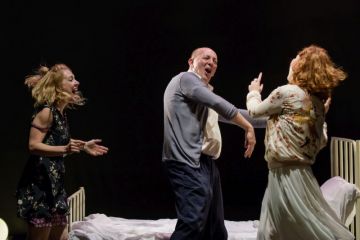2h 20' without intermission
The production is built around the mentally instable Blanche, who controls the events within the play, making the scenery become a mere instrument of the performance. The shaping of characters has perhaps never been such a powerful and central factor in the performances presented at the Hungarian Theatre of Cluj. Imola Kézdi’s acting is exquisite, masterfully playing not only with her gestures, movement, and tone, but also with the sparkle in her eyes and its dimming, mesmerizing the viewer into believing Blanche is not far from our own selves.
Simply put, it is the clash of two worlds: of reality and appearance. The husband, the wife and their friends represent down to earth people who are struggling to live from one day to the next, while the newly arrived family member is thrust upon them in the form of a woman who is chasing her own lost dreams, and is already on the verge of insanity. The irreconcilable oppositions are obvious from the beginning, as the playwright leads the actors - and obviously his audience - with his masterful hand through the complications that unfold within the play.
There are, in fact, at least two or three moments within the performance in which this type of desire reaches a paroxysm, and the actors called to scenically transpose this quasi-animalistic feeling do so with their participation and concentration brought to perfection. (...) In fact, in Tom Dugdale's production, well-tempered stanislavskiism is associated with a measured and controlled type of Brechtism. A level of balance achieved due to the director, the actors, and the confidence shown to the ensemble by Tom Dugdale. The most obvious proof of the aforementioned trust seems to me to be the courageous and successful casting of Lóránd Farkas in the role of Stanley Kowalsky.
All that being said, it's a pleasure to see how Imole Kézdi succeeds in moving from madness to depression, or from negotiation to anger. Her character is present on stage for almost the entire performance, which requires a great deal of effort and energy. However, she knows how to carefully dose her resources, and the end result is a role for which the term natural is the "perfect label". I have previously seen Loránd Farkas on stage, but I believe that here he demonstrates his ability to play a character role anytime, where the breadth of emotions and the detailed construction of the character’s defining traits - at the level of gestures, voice and concrete reference to the space and other characters around him – represent the defining elements. In other words, incarnating Stanley became a standard for Farkas against which to measure his professional might. None of the other actors are lesser than these two, indicative of the fact that Dugdale has worked a great deal on the group performance as such, however, given the breadth of these two portrayals, they will remain the benchmarks needed whenever we would like to utterly enjoy a performance of A Streetcar Named Desire. And what I saw was a good to a very good production, mostly thanks to these two actors.
Date of the opening: June 28, 2017
A Streetcar Named Desire is an outrageous play, filled with outrageous dreams, dreamers, and violence — both physical and psychological. The play deals with one of the most sickening human impulses: the desire to destroy the outsider, the foreigner, the one whose lifestyle is different from your own. But it is not a cold play. Over its roughest parts is stretched a skin of love and sex that disarms the violence, at least until morning. Slaps melt into embraces, bruises get caressed. The characters desire each other, but even more, they desire peace. Peace from the voices chattering endlessly in their heads. Peace from their past. And hopefully, an answer to the question of how to travel through this world: living together is dangerous, but living alone is impossible. So which will it be?
Tom Dugdale

































